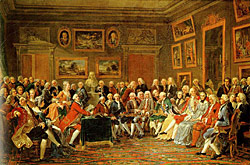
Unit 3: Revolutions and Reaction
Lesson A: Conflict and Progress in the European World
Lesson Overview
England in the 17th century was a country in transition - influenced by the printing press, a civil war, the Glorious Revolution, and ideas from the Enlightenment. English kings competed with foreign powers for land and resources setting off numerous conflicts. England not only fought multiple wars with Spain, France, and the Netherlands in the 17th century, it was torn by Civil War, which divided it along religious, social, and ethnic lines. These wars required money and resources, which were largely funded through new wealth acquired from trade, and of course, taxes. Heavy taxes led English commoners, in part due to their own newfound wealth, to question the authority and ability of the King to tax without their consent. The result was a new way to think about government. It was a way of thinking that would change the world.
Key Questions
- What social, political, and economic conditions lead to the overthrow of established ideas?
- How does nationalism impact countries and people?
- How do artifacts and documents influence how history is written?
Student Outcomes
- Explain how the English Civil War and the Revolution of 1688 affected government, religion, economy, and society in Britain as well as the American colonies.
- Analyze the causes of the European Enlightenment including political stability, the scientific revolution, weakened church influence, cultural diffusion and exchanges, and international trade.
- Describe Enlightenment ideas about human rights and government, including democratic ideas, and how Enlightenment thinkers used the printing press to spread new ideas.
- Analyze cause-and-effect relationships and multiple causation, including the importance of the individual and the influence of ideas. (Historical Thinking Skill)
- Consider and compare multiple perspectives in primary and secondary sources. (Historical Thinking Skill)
Key Terms
Student Resources
- England's Glorious Revolution Historical Investigation (doc)
- Glorious Revolution Graphic Organizer (doc)
- Origins of Enlightenment Graphic Organizer (doc)
- The Enlightenment of Europe Historical Investigation (doc)
- Conflict and Progress in Europe Brief Constructed Response (doc)
Chart of Activities
| Activities to Complete | Estimated Time |
|---|---|
| Pre-Assessment | 5 minutes |
| Key Terms | 5 minutes |
| Activator: The Rise of a European World | 5 minutes |
| Opening: From the Middle to Early Modern Age | 10 minutes |
| Activity 1: A Divided England | 15 minutes |
| Activity 2: A Glorious Time for Democracy | 15 minutes |
| Activity 3: Causes and Effects of Political Changes | 10 minutes |
| Activity 4: From Word of Mouth to Words on a Page | 15 minutes |
| Activity 5: The Birth of the Enlightened Age | 15 minutes |
| Activity 6: An "Enlightened" Europe | 15 minutes |
| Review and Assessment | 20 minutes |
| Lesson Summary | 5 minutes |
Lesson Completion Time
The total estimated time to complete this lesson is 135 minutes.
Page Notes:
[1] Source: This image from http://en.wikipedia.org/wiki/File:Salon_de_Madame_Geoffrin.jpg is in the public domain because its copyright has expired.



